
|
|||
|---|---|---|---|
|
|
Determination of basic parameters of physical fitness of Ecuadorian population. MINDE-UG Project Determinación de parámetros básicos de aptitud física de la población ecuatoriana. Proyecto MINDE-UG |
|
|
|
*Project of Ministry of Sports and University of Guayaquil (Ecuador) **University of Guayaquil-Prometheus Program, Senescyt (Ecuador) Army University (Ecuador) ***Andrés Bello National University, (Chile) |
Econ. Elizabeth Flores Abad* Dr.C. Santiago Calero Morales** Mag. Claudia Arancibia Cid* *** Mag. Gonzalo García Menéndez* |
|
|
|
Abstract This research project determines the basic indicators used in the sciences of Physical Activity and Sports in order to assess the population characteristics in functional capabilities and the possibilities of athletic performance. A representative sample of 6,902 individuals was used to study the Vertical Jump Power; 3,066 individuals to study the Horizontal Jump Power; 10,211 individuals to study the Local Muscular Power (Abs); 10,213 individuals for Rapid Strength and Agility, 10,285 for Peak Oxygen Uptake and 10,285 individuals studied with the Trunk Flexibility test. This article evaluates the information generally because it totals real data of subjects aged between 5 to 18 years old without strata distinction. It describes the untrained population of Ecuador from the quantitative point of view. It corresponds to a segment of a study that defines national parameters aimed at the development of sports. Keywords: Indicators. Fitness. Test. Ecuador.
Acknowledgements To the Prometheus Program of the National Secretary of Higher Education, Science, Technology and Innovation of Ecuador (Senescyt) and to the Anthropometric Measurement and Study Analysis Project in search of Possible Sports Talents of the Ministry of Sports and the University of Guayaquil, of the Republic of Ecuador.
|
|||
|
|
EFDeportes.com, Revista Digital. Buenos Aires, Año 19, Nº 196, Septiembre de 2014. http://www.efdeportes.com/ |
|
|
1 / 1
Introduction
The assessment of athletic performance, both from a biological, psychological, educational or end performance point of view, usually is one of the key components of the management process of sports training. According to Viru, A. & Viru, M. (2003) the training load is usually evaluated from the biological point of view through blood or urine analysis, using metabolic and hormonal criteria to get aware of the effect of the training session, therefore the biological conditions are usually extremely valuable and well studied by related scientists such as Fernández, Delgado, B. & Delgado, M. (2003); Kreider, Leutholtz, Katch & Katch (2009), among others. Moreover, the performance conditions based on psychological control value indicators such as competitive stress and the link with biological growth (Stafford, 2011), the willingness to win (Kremer & Moran, 2013) and other aspects of the preparation of the athlete, while the final performance is evaluated primarily on the stage of maximum performance in sports (Calero, 2009) or as part of the competition itself (Weinberg, 2010; Calero, 2011; Lebed & Bar-Eli, 2013).
Since sports performance is expressed through various interrelated factors (Fiedler, 1974), the integrality in the athletic performance evaluation tests is often a priority factor, therefore the use of a broad group of tests to help creating a multilateral concept of the trained individual, is completely justified (Matveev, 2001), which is the same as a pedagogical or integral expression in the control of physical performance (Platonov & Bulatova, 2001).
Several studies have been aimed at describing the population of a country with sports performance indicators in order to detail the characteristics or variables that have a significant influence on the performance, depending on the requirements of each sport, an aspect that contributes to the development of methodological actions to be implemented at short or long term, among other aspects, strategic work evidence for the detection of sports talents.
Among the priority tests are those that measure flexibility, given the importance of this physical ability in the prevention of sports injuries (Eraña & Martínez, 2001; Witvrouw, Danneels, Asselman, D'Have & Cambier, 2003; Valbuena, 2007). The vertical and horizontal jump tests are often useful to evaluate the existing power in the lower limbs, given the importance of that musculoskeletal system in specific sports, investigating several variables that affect its effectiveness such as coordination (Nagano, Komura & Fukashiro, 2007). Since the objective of aerobic training is to achieve a progressive increase in the maximal oxygen consumption in a more efficient way, the VO2 max evaluation tests become extremely useful to determine performance indicators such as the study of Das (2013). On the other hand, measuring specific muscle power, which is the case with the straight and oblique abs, becomes important because of the amount of internationally existing conditions which allows, among other things, a comparison with various studies to determine, which is the case of the study of Vispute, Smith, LeCheminant & Hurley (2011), how exercise influences in the reduction of abdominal fat, among other things of interest. Another useful test is the one that has a level of integrality in its concept of motor skills execution, such as the Rapid Strength and Agility Test used in this study, which allows to control several indicators at once, valued in different international studies such as the study of Bloomfield, Polman, O'Donoghue & McNaughton (2007), which compare two methodologies to assess speed and agility in a study group.
The talent selection itself requires the application of physical performance evaluation tests to verify the future scope and limitations of the sports training process, therefore its implementation is consistent with very young ages because the sports selection happens during early ages (Blázquez et al, 1996;. García et al, 2003; Calero & Suárez, 2011).
This research concentrates on the existing population in Ecuador, using a representative study sample according to the calculations of simple random sampling of Calero (2003), specifying the total values studied in the country, indicating its peculiarities to help drawing conclusions that lead to better decision-making. Six internationally accepted tests are applied and used in different specialized investigations and bibliographies such as Norton & Olds (2000), Collins & Hodges (2001), Martínez (2002) and Villera & Petro (2010), of which a synthesis can be seen in the methodology section. The test results essentially provide quantitative indicators to draw qualitative conclusions, mainly from the resulting percentiles, which is the case of the works of Calero, Suárez & Fernández (2012a; 2012b).
This article aims at quantitatively describing the population of the Republic of Ecuador by applying six tests that measure some physical capabilities that are used for the future selection of sports talents.
Material and methods
In this paper, the physical performance evaluation tests, which are listed below, were applied to the study sample drawn from 23 of Ecuador's provinces, with different untrained randomly selected subjects between 5 and 18 years old.
-
Vertical Jump Power (VJP). 6,902 individuals were studied.
-
Horizontal Jump Power (HJP). 3,066 individuals were studied.
-
Local Muscular Power (LMP). 10,211 individuals were studied.
-
Rapid Strength and Agility (RSA). 10,213 individuals were studied.
-
Peak Oxygen Uptake (VO2 max). 10,285 individuals were studied.
-
Trunk Flexibility (TF). 10,285 individuals were studied.
The techniques of the tests correspond to internationally accepted evaluation batteries for children and adolescents that are used in the field by professionals who attended and also approved the ISAK kinanthropometry certifications. SPSS V20 was used to process the information with different statistical indicators such as the 5th, 15th, 25th, 50th, 75th, 85th and the 95th percentile, the Arithmetic Mean, Minimum and Maximum values, among others.
Methodology
The selected variables seek to identify the physical and motor skills attributes in the formation of the probable athlete, according to the applied tests described below:
1. Horizontal Jump Power (HJP). Explosive lower body strength test. It consists of making a maximum jump with take-off of arms and legs and without prior run (from standing position), measured in centimeters, the distance to fall. This test was only applied to individuals between 5 and 9 years old.
2. Vertical Jump Power (VJP). Vertical Jump Test (Sargent Jump). Used to measure the maximum capacity of the extensor muscles for the development of high intensity motor skills activities. It consists of making a maximum jump with take-off of arms and legs. This test was applied to groups of individuals between 10 and 18 years old.
The result of this test is the obtained difference between the first and second mark, measuring the take-off distance in centimeters. For the calculation of the maximum power of the jump, the Harman formula (1991) was used.
3. Local Muscular Power (LMP). Abs test. It is based on performing as many repetitions of abdominal exercises in one minute. The start angle of the movement is set to 40° (relative to the floor) and the end position is set to an angle of 90°. The number of repetitions is computed at the agreed time. For child populations (including children up to 9 years old), the test time is reduced to 30 seconds.
4. Rapid Strength and Agility (RSA). Agility test. Running back and forth. It consists of running back and forth between two parallel lines located at a distance of 10 meters apart, picking up and carrying two wooden blocks to the opposite line (one at a time). The final route consists of 4 races of 10 meters each, which includes the reaction, acceleration, stopping, change of direction and hand-eye coordination rate. The time required per route is noted. Applicable to all ages.
5. Peak Oxygen Uptake (VO2 max). Multi-stage fitness test or Leger-test. It consists of a test of progressive intensity, running continuously back and forth at a predetermined pace. It consists in running as long as possible on a route of 20 meters in both directions back and forth at the pace of a beep. This signal is measured in a way that the initial velocity is 8 km/h and increases by 0.5 km/h at one-minute intervals. Every time the signal sounds, the individual must be on either end of the 20 m route. The test is finished when the individual cannot keep up with the pace of the race. The oxygen consumption is estimated indirectly, calculated on the average energy cost of the running velocity reached during the last complete charge and the age of the individual, from the following equation:
VO2 max. = estimation of maximal oxygen consumption (ml/kg/min)
V = maximum velocity reached during the last completed half (km/h)
A = Age of the subject
6. Trunk Flexibility (TF). Trunk Flexibility Test. Also called Wells Test. It measures the flexibility of the lower back, the hip extensors and the knee flexors. It consists of performing a trunk flexion in sitting position, holding both legs extended, leaning on a "crate". The idea of the test is to pass the line of the feet with both arms extended. The distance reached is measured in centimeters. If this distance coincides with the line of the feet, then it is zero (0), if it is higher, then it is noted as positive, if it is lower, then it is noted as negative.
Results
Table 1. Total Physical Indicators of the Republic of Ecuador. Horizontal Jump Power (HJP)
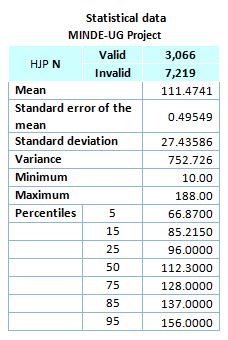
For the study of Horizontal Power 7,219 individuals from the Republic of Ecuador were randomly analyzed with the prescribed indicator (HJP) by a test designed to assess the explosive lower body strength. The national average was at 111.44741 cm with a National Minimum of 10.00 cm and a Maximum of 188.00 cm. The reference percentile is located at cut 95, so it is estimated at 156.00 cm.
Table 2. Total Physical Indicators of the Republic of Ecuador. Vertical Jump Power (VJP)
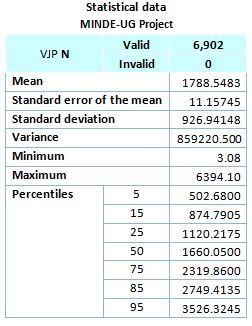
The Republic of Ecuador has an average of Vertical Jump (VJ), measured in Vertical Power of 1788.5483 watts, taking into account the total amount of individuals measured without any distinctions. A Minimum of 3.08 watts and a Maximum of 6394.10 watts appeared. The 95thpercentile, positive optimal value for the selection of sports talents, was estimated at 3526.3245 watts.
Table 3. Total Physical Indicators of the Republic of Ecuador. Local Muscular Power (LMP)
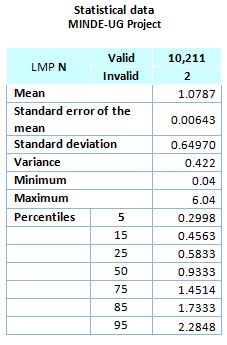
In table 3 an absolute frequency of 10,211 individuals studied as a representative sample was used.
The Republic of Ecuador has an Average in the Local Muscular Power test (LMP) of 1.0787 repetitions per second (r/s) in the abdominal test with a Minimum indicator of 0.4 r/s and a Maximum indicator of 6.04 r/s. Furthermore, the 95thpercentile shows that the national cut is set to 2.2848 r/s.
Table 4. Total Physical Indicators of the Republic of Ecuador. Rapid Strength and Agility (RSA)
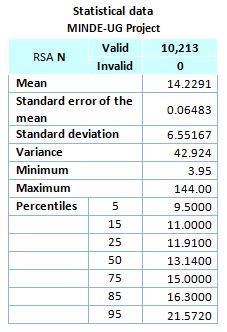
In the previous table an absolute frequency of 10,213 individuals studied as a representative sample was used. Ecuador has a total population measured in terms of Rapid Strength and Agility (RSA) of 14.2291 s while a Minimum index of 3.95 s and a Maximum index of 144 s appeared. The 5th percentile, suitable minimum value, was set to a duration of 9.5 s during the Rapid Strength and Agility test.
Table 5. Total Physical Indicators of the Republic of Ecuador. Peak Oxygen Uptake (VO2 max)
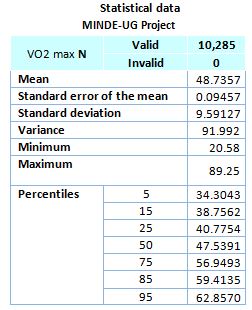
To obtain the total values of the Republic of Ecuador 10,285 individuals from different strata were studied. The Peak Oxygen Uptake (VO2 max) in terms of Arithmetic Mean was nationally set to 48.7357 ml/kg/min with a Minimum of 20.58 ml/kg/min and a Maximum of 89.25 ml/kg/min, while the 95th percentile was at 62.8570 ml/kg/min.
Table 6. Total Physical Indicators of the Republic of Ecuador. Trunk Flexibility (TF)
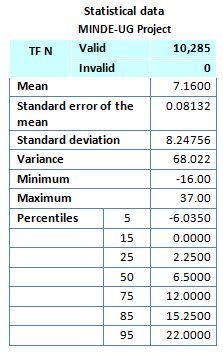
For this study a population sample of 10,285 untrained individuals of the Republic of Ecuador, measured with the Trunk Flexibility test (TF), was used.
The national average was estimated at 7.1500 cm with a Minimum value of -16.00 cm and a Maximum national value of 37.00 cm. The 95thpercentile was established at 22.00 cm for the ages studied.
Discussion
The results in this segment of the analysis of the different physical fitness tests show general characteristics of the population in the Republic of Ecuador, particularized with a higher degree of variability in the analysis of results of the MINDE-UG project considering factors such as sex, as envisaged in the works of Calero, Suárez & Fernández (2012a; 2012b) as well as other more specific strata of demographic order such as age ranges, ethnicity, socioeconomic stratification and urban and rural zoning, among other aspects of interest.
During the registration process and the processing of data, there has been a special interest in Objectivity, Reliability and Validity, as laid down in Martínez (2002) and in Calero (2009), aimed at achieving rates of scientific accuracy suitable for this type of study, therefore, as a scientific strategy, professional standards were assured in the different measurements through duly certified training courses.
By obtaining a representative sample of the population with the Unrestricted Random Sampling formula from Arístides Calero (2003), higher reliability rates have been guaranteed in the results, considering the fact that the sample exceeds the total requirements to study the population (a higher number of individuals than the minimum obtained with the outlined formula was studied), which causes a decrease in the Type I and Type II statistical margins of error.
We agree with the outlined authors and researchers such as Norton & Olds (2000), Collins & Hodges (2001), Martínez (2002) and Villera & Petro (2010), on the importance of applying performance control techniques through different assessment tests, which meets the assumptions of Matveev (2001) that the training process itself has a multilateral concept, with an emphasis on its eminently pedagogical and comprehensive nature, as expressed in the work of Platonov & Bulatova (2001).Therefore, six physical performance evaluation tests were selected in order to have a more comprehensive view of the process.
Since the sports selection process is multifactorial like the management of the sports performance, the selection of these six tests allows us to quantitatively describe the study population from the holistic point of view. The classification and subsequent decision-making process related to the human health process, screening, selection and sports initiation is based on science, intuition and experience, therefore, these studies allow us to establish the foundations for a correct policy that increases the national rates of social welfare, health and motor skills education.
Conclusions
In this segment of the study several indicators were established. These indicators describe the population of Ecuador in terms of basic physical abilities at ages between 5 to 18 years old with which overall statistics were processed. Since the total values are generic, the indicator of the functional skills sets the descriptive characteristics. It is recommended that, for decision-making, the more specific statistical classification with more detailed inferences is used, which will enable the optimization of the sports talent selection processes in the Republic of Ecuador.
References
-
Arregui Eraña, J.A. y Martínez de Haro, V. (2001). Estado actual de las investigaciones sobre la flexibilidad en la adolescencia. Revista Internacional de Medicina y Ciencias de la Actividad Física y el Deporte vol. 1 (2) p. 127-135.
-
Blázquez, D. y col. (1996). La iniciación deportiva y el deporte escolar. INDE, España. pp. 41-42.
-
Bloomfield J., Polman R. O'Donoghue P. y McNaughton L. (2007). Effective speed and agility conditioning methodology for random intermittent dynamic type sports. J Strength Cond Res. 21(4), 1093-1100. USA.
-
Calero, A. (2003). Estadística III. Editorial Félix Varela, La Habana, Cuba. pp.61
-
Calero, S. (2009). Sistema de registro y procesamiento del rendimiento técnico-táctico para el voleibol de alto nivel (Doctoral disertación, Tesis en opción al grado científico de doctor en ciencias de la Cultura Física. Departamento de Juegos Deportivos. Universidad de las Ciencias de la Cultura Física y el Deporte “Manuel Fajardo”, La Habana. Cuba).
-
Calero, S. (2011). Variables significativamente influyentes en el rendimiento del pasador de voleibol. Revista Internacional de Medicina y Ciencias de la Actividad Física y el Deporte vol. 11 (42) pp. 347-361
-
Calero, S. y Suárez, C. (2011). Acciones para perfeccionar la selección de talentos del voleibol en los programas cubanos de deporte escolar. EFDeportes.com, Revista Digital. Buenos Aires - Año 16 - Nº 156 – Consultado el 30 de Julio del 2014 en la Web: http://www.efdeportes.com/efd156/perfeccionar-la-seleccion-de-talentos-del-voleibol.htm
-
Calero, S., Suárez, C. y Fernández, A. (2012a). Determinación de las escalas de valores del rendimiento técnico-táctico ofensivo del voleibol cubano. Parte 1. EFDeportes.com, Revista Digital. Buenos Aires, Año 15, Nº 166. Consultado en 03 de Agosto en la Web: http://www.efdeportes.com/efd166/escalas-del-rendimiento-ofensivo-del-voleibol.htm
-
Calero, S., Suárez, C. y Fernández, A. (2012b). Determinación de las escalas de valores del rendimiento técnico-táctico ofensivo del voleibol cubano. Parte 2, final. EFDeportes.com, Revista Digital. Buenos Aires, Año 17, Nº 167, Abril de 2012. Consultado en 03 de Agosto en la Web: http://www.efdeportes.com/efd167/escalas-de-valores-del-rendimiento-del-voleibol-2.htm
-
Collins, D. & Hodges, P. (2001). A Comprehensive Guide to Sports Skills Tests and Measurement. Scarecrow Press. USA.
-
Das, B. (2013). Estimation of maximum oxygen uptake by evaluating cooper 12-min run test in female students of West Bengal, India. Journal of Human Sport & Exercise. Universidad de Valencia, España. 10.4100/jhse.2013.84.11
-
Fernández, B.F., Delgado, B. y Delgado, M. (2003). La preparación biológica en la formación integral del deportista. Editorial Paidotribo. Barcelona, España.
-
Fiedler, M. y col (1974). Voleibol. RDA: Leipzig. pp. 239-256.
-
García y col, (2003). El talento deportivo. Formación de elites deportivas. Editorial Gymnos. Madrid, España. pp14
-
Kreider, R.B., Leutholtz, B., Katch, F.I. y Katch, V.L (2009). Exercise and Sport Nutrition. Exercise & Sport Nutrition. USA.
-
Kremer, J. y Moran, A. (2013). Pure Sport, 2nd Edition: Practical Sport Psychology. Routledge. USA.
-
Lebed, F. y Bar-Eli, M. (2013). Complexity and Control in Team Sports: Dialectics in contesting human systems. Routledge. USA. p.183-187
-
Martínez, E.J. (2002). Pruebas de aptitud física. Editorial Paidotribo, Barcelona, España.
-
Matveev, L.P. (2001). Teoría general del entrenamiento deportivo. Editorial Paidotribo. Barcelona, España. p.110
-
Nagano, A., Komura, T. y Fukashiro, S. (2007). Optimal coordination of maximal-effort horizontal and vertical jump motions – a computer simulation study. Bio Medical Engineering On Line. Consultado el 31 de julio del 2014 en la Web: http://www.biomedical-engineering-online.com/content/pdf/1475-925X-6-20.pdf
-
Norton, K. y Olds, T. (2000). Antropométrica. Biosystem Servicio Educativo. Rosario, Argentina.
-
Platonov, V. y Bulatova, M. (2001). La preparación física. Editorial Paidotribo. Barcelona, España. p.361-400
-
Stafford, I. (2011). Coaching Children in Sport. Taylor & Francis. USA. p.248-249
-
Valbuena, R. (2007). Evaluación y normas para la clasificación de la capacidad física Flexibilidad considerando personas entre 9 y 50 años de edad pertenecientes al Distrito Capital de la ciudad de Caracas. Revista de Investigación vol.31 no.61.
-
Villera, S. y Petro, J.L (2010). Valoración de la aptitud física de los escolares de 10 a 12 años de Montería, Colombia. EFDeportes.com, Revista Digital. Buenos Aires, Año 15, Nº 148. Consultado el día 01 de Agosto del 2014 en la Web: http://www.efdeportes.com/efd148/valoracion-de-la-aptitud-fisica-de-los-escolares.htm
-
Viru, A. y Viru, M. (2003). Análisis y control del rendimiento deportivo. Editorial Paidotribo, Barcelona, España. p. 173-174
-
Vispute SS1, Smith JD, LeCheminant JD, Hurley KS. (2011). The effect of abdominal exercise on abdominal fat. Journal of Strength & Conditioning Research: Sep;25(9):2559-64.
-
Weinberg, R. (2010). Fundamentos de psicología del deporte y del ejercicio físico. Ed. Médica Panamericana, Madrid, España. p.105-116
-
Witvrouw, E., Danneels, L., Asselman, P., D’Have, T. y Cambier. D. (2003). Muscle Flexibility as a Risk Factor for Developing Muscle Injuries in Male Professional Soccer Players: A Prospective Study. Am. J. Sports Med. 2003; 31; 41. USA.
Another articles In English
 |

Búsqueda personalizada
|
|---|---|
|
EFDeportes.com, Revista
Digital · Año 19 · N° 196 | Buenos Aires,
Septiembre de 2014 |
|
